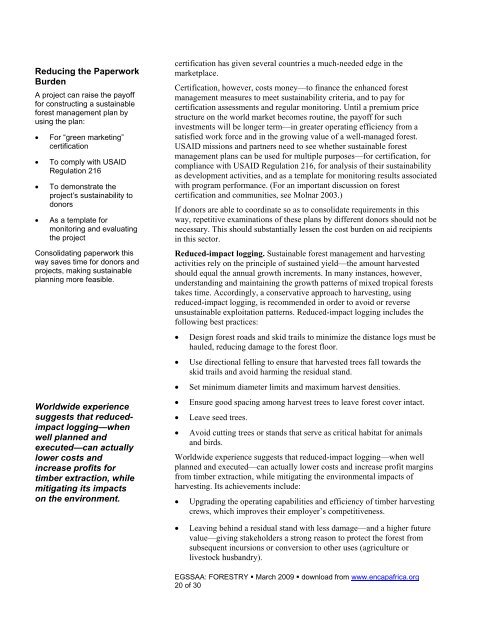Chapter 7 Forestry: Reforestation, Natural Forest Management
Chapter 7 Forestry: Reforestation, Natural Forest Management
Chapter 7 Forestry: Reforestation, Natural Forest Management
Create successful ePaper yourself
Turn your PDF publications into a flip-book with our unique Google optimized e-Paper software.
Reducing the PaperworkBurdenA project can raise the payofffor constructing a sustainableforest management plan byusing the plan:• For “green marketing”certification• To comply with USAIDRegulation 216• To demonstrate theproject’s sustainability todonors• As a template formonitoring and evaluatingthe projectConsolidating paperwork thisway saves time for donors andprojects, making sustainableplanning more feasible.Worldwide experiencesuggests that reducedimpactlogging—whenwell planned andexecuted—can actuallylower costs andincrease profits fortimber extraction, whilemitigating its impactson the environment.certification has given several countries a much-needed edge in themarketplace.Certification, however, costs money—to finance the enhanced forestmanagement measures to meet sustainability criteria, and to pay forcertification assessments and regular monitoring. Until a premium pricestructure on the world market becomes routine, the payoff for suchinvestments will be longer term—in greater operating efficiency from asatisfied work force and in the growing value of a well-managed forest.USAID missions and partners need to see whether sustainable forestmanagement plans can be used for multiple purposes—for certification, forcompliance with USAID Regulation 216, for analysis of their sustainabilityas development activities, and as a template for monitoring results associatedwith program performance. (For an important discussion on forestcertification and communities, see Molnar 2003.)If donors are able to coordinate so as to consolidate requirements in thisway, repetitive examinations of these plans by different donors should not benecessary. This should substantially lessen the cost burden on aid recipientsin this sector.Reduced-impact logging. Sustainable forest management and harvestingactivities rely on the principle of sustained yield—the amount harvestedshould equal the annual growth increments. In many instances, however,understanding and maintaining the growth patterns of mixed tropical foreststakes time. Accordingly, a conservative approach to harvesting, usingreduced-impact logging, is recommended in order to avoid or reverseunsustainable exploitation patterns. Reduced-impact logging includes thefollowing best practices:• Design forest roads and skid trails to minimize the distance logs must behauled, reducing damage to the forest floor.• Use directional felling to ensure that harvested trees fall towards theskid trails and avoid harming the residual stand.• Set minimum diameter limits and maximum harvest densities.• Ensure good spacing among harvest trees to leave forest cover intact.• Leave seed trees.• Avoid cutting trees or stands that serve as critical habitat for animalsand birds.Worldwide experience suggests that reduced-impact logging—when wellplanned and executed—can actually lower costs and increase profit marginsfrom timber extraction, while mitigating the environmental impacts ofharvesting. Its achievements include:• Upgrading the operating capabilities and efficiency of timber harvestingcrews, which improves their employer’s competitiveness.• Leaving behind a residual stand with less damage—and a higher futurevalue—giving stakeholders a strong reason to protect the forest fromsubsequent incursions or conversion to other uses (agriculture orlivestock husbandry).EGSSAA: FORESTRY • March 2009 • download from www.encapafrica.org20 of 30
















